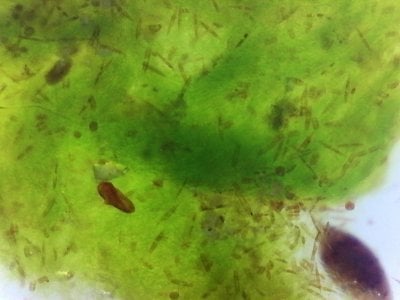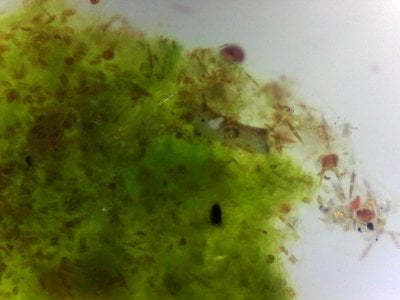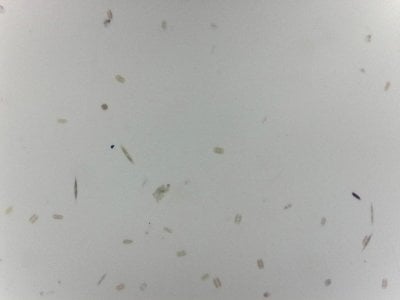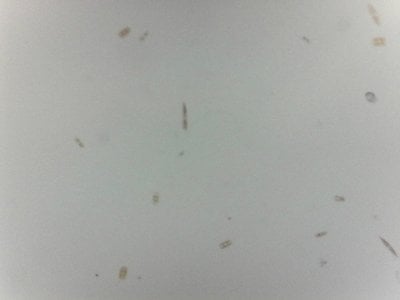Navigation
Install the app
How to install the app on iOS
Follow along with the video below to see how to install our site as a web app on your home screen.
Note: This feature may not be available in some browsers.
More options
You are using an out of date browser. It may not display this or other websites correctly.
You should upgrade or use an alternative browser.
You should upgrade or use an alternative browser.
Dinoflagellates – Are You Tired Of Battling Altogether?
- Thread starter mcarroll
- Start date
- Tagged users None
No sir, not yet. I have reduced my peak intensity to 5 hours, with one hour ramp up/down on either end. I also reduced the overall peak intensity to less than 30%.Have you tried a blackout?
Tonight I will tape cardboard to the tank and black it out. Is 72 hours standard?
No sir, not yet. I have reduced my peak intensity to 5 hours, with one hour ramp up/down on either end. I also reduced the overall peak intensity to less than 30%.
Tonight I will tape cardboard to the tank and black it out. Is 72 hours standard?
72 is standard but some have gone as much as 120 (5 days). If you don't change anything else. It will likely come back after the blackout. You'll want to have your nutrient levels in place (looks like you do) and have predators in place(pods, cleanup crew). That way, any dinos that make it through the blackout have little to no chance of dominating the tank again. You are lucky that they are photosynthetic.
Also if you can run filter socks, change them out daily while doing the blackout. You will be physically removing the dinos since they leave the sand/rock during lights out and swim around in the water column. A UV sterilizer is also an alternative. I used filter socks.
I wash my filter socks in the washing machine with a cup of bleach. Run an extra rinse cycle and let dry for a day or two.
I wash my filter socks in the washing machine with a cup of bleach. Run an extra rinse cycle and let dry for a day or two.
It's brown, snotty, stringy, produces bubbles that get trapped in the snotty matrix, it's on the rockwork and the sand bed. It disapears at night and re appears during the day. It wants to cover any coral like a spider web.
I'm at work at the moment, but here are a couple of pics saved in my phone. I tried to enhance them best I could.


Looks alot like what i had in the web / stringy formation
Ok, 72 it is then. Looks like I'll be making the trek to the lfs tomorrow for pods. My CUC is mainly BL hermits, astrea and turbo snails. So far none of the snails have shown symptoms of toxicity to these dinos, but the dinos like to cover their shells.72 is standard but some have gone as much as 120 (5 days). If you don't change anything else. It will likely come back after the blackout. You'll want to have your nutrient levels in place (looks like you do) and have predators in place(pods, cleanup crew). That way, any dinos that make it through the blackout have little to no chance of dominating the tank again. You are lucky that they are photosynthetic.
Reef Cleaners has some really great prebuilt packs for CUCs. Just pick your tank size. The snails they use in their packs are supposed to eat dinos. Thats what they claim anyway.
I've been following for a while and now officially throwing my hat into the ring as well. Hello, my name is Kyle and I had Dinos...
I started dosing nitrates and phosphates before right before Irma, but that threw things off so even though I've been dosing for a week, I'm counting yesterday as my day 1 as I can now test/dose daily.
I previously had:
No3: 0 - I'd call it a very hard 0 as well, it never fluctuated for months.
Po4: .03
Now:
No3: 10
Po4: .12
I sift my sand daily with a turkey baster. Should I keep doing this?
I run a UV 24/7 (for about a month to not much effect). Should I keep running this or allow algae to start to grow for a while?
I started dosing nitrates and phosphates before right before Irma, but that threw things off so even though I've been dosing for a week, I'm counting yesterday as my day 1 as I can now test/dose daily.
I previously had:
No3: 0 - I'd call it a very hard 0 as well, it never fluctuated for months.
Po4: .03
Now:
No3: 10
Po4: .12
I sift my sand daily with a turkey baster. Should I keep doing this?
I run a UV 24/7 (for about a month to not much effect). Should I keep running this or allow algae to start to grow for a while?
Blackout has begun.

That's dedication.
I've seen more coraline algae growing. And my Blastomussa coral has pushed out a new polyp. Added a new lr and my ammonia has jumped just a bit to .25. It was was almost 4 1/2 lbs. some die off. To be expected.
I've seen more coraline algae growing. And my Blastomussa coral has pushed out a new polyp. Added a new lr and my ammonia has jumped just a bit to .25. It was was almost 4 1/2 lbs. some die off. To be expected.
Last edited:
@XNavyDiver If you don't already have a thread of your own where all your tank pics and details can be summarized together, you should make one. Link it here and/or PM me. (It gets a little hard to track everyone's details here when the thread gets moving quickly.) 
Since it disappears at night, it could be going into the water column or down into the sand bed.
If it's a variety that goes up, then chances are that #UV and/or #diatom filtration will help a lot.
Spousal Support Factor
As far as expenses related to fixing this scenario, assuming so far that it's a dino bloom, you won't need anything more than a $12 toy scope (check out Selecting a microscope) and another $12 or so in N and P additives. Not a whole lot.
"Extras" you might opt for would be :
I've been in a similar position – tough, but not the end of the world. The internet makes a huge difference, but the using the internet for info comes with it's own issues.
I hope you're working on building out your library of reefing books!
 Plan to spend about 2-10x more time reading (offline!) than the next guy...but it'll be worth it. See what your public library system can get access to. Even if your local branch doesn't have anything, they often have access to materials from outside. In addition to books, find out if you can get back issues of aquarium magazines and read everything you can. Used book stores can be a good resource too, if you have any locals.
Plan to spend about 2-10x more time reading (offline!) than the next guy...but it'll be worth it. See what your public library system can get access to. Even if your local branch doesn't have anything, they often have access to materials from outside. In addition to books, find out if you can get back issues of aquarium magazines and read everything you can. Used book stores can be a good resource too, if you have any locals.
Consider starting a club! Put an ad in the paper or on craigslist and list it at the LFS you go to. Doesn't have to be anything more than two folks meeting up.....and the meetup doesn't even have to be in person these days.
 Get something started!
Get something started! 
Since it disappears at night, it could be going into the water column or down into the sand bed.
If it's a variety that goes up, then chances are that #UV and/or #diatom filtration will help a lot.
Spousal Support Factor
As far as expenses related to fixing this scenario, assuming so far that it's a dino bloom, you won't need anything more than a $12 toy scope (check out Selecting a microscope) and another $12 or so in N and P additives. Not a whole lot.
"Extras" you might opt for would be :
- Marineland's Magnum Polishing Filter (a diatom filter) seems to go for about $65.
- A much larger Vortex model goes for $150 and up, depending if you need the pump to go with it.
- The cannister-only version of the Vortex with 5/8" ports is only $72.
- UV filters seem to be in the same price range.
- Some folks have inoculated their tanks with some new pieces of live rock, live sand or even detritus from a healthy system. Price can be from free up to the price of live rock. Shouldn't need more than a cup for a single inoculation unless it's a really big tank.
- Am I forgetting any other popular add-on strategies?
One of my unfortunate problems is where I live. There is no local reef club to turn to for support.
I've been in a similar position – tough, but not the end of the world. The internet makes a huge difference, but the using the internet for info comes with it's own issues.
I hope you're working on building out your library of reefing books!
Consider starting a club! Put an ad in the paper or on craigslist and list it at the LFS you go to. Doesn't have to be anything more than two folks meeting up.....and the meetup doesn't even have to be in person these days.
You are lucky that they are photosynthetic.
We would all be lucky if they were so simple......total Jekyl and Hyde.
Jekyl
When they're photosynthetic (autotrophs) we don't even know they're there. Apparently they don't form blooms when they're just using dissolved nutrients and carbon from photosynthesis.
Hyde
When they get triggered by N or P starvation or whichever combination of environmental cues, they start acting like heterotrophs and eat their way out of starvation. The carbon fixed by their now-redundant photosynthetic organ now gets channeled into toxin and mucus generation so they can avoid getting predated upon while they are starving. Good strategy, no? :mad:
So far none of the snails have shown symptoms of toxicity to these dinos, but the dinos like to cover their shells.
Sure would like more confirmation that it's dino's....and a microscope pic would be the best. (I know.) Sorry if this is a repeat question, but did you do the "dino test" where you shake up a sample?
The snails they use in their packs are supposed to eat dinos. Thats what they claim anyway.
Hm.
I would be hesitant to add that big of a CUC at once to almost any tank. Can you find someone (or two+ someones) to split an order with?
I run a UV 24/7
I would keep up what you're doing. Do you already have a thread that has some more details (pics, test results, etc) about your system and situation? Link here and/or PM me!
It was was almost 4 1/2 lbs. some die off. To be expected.
Keep an eye on things....that was a pretty fair amount of rock to add all at once. Hopefully you won't see any negative reactions.
If anyone else wants to try this, a few small pieces of should be all you need. A pound or so....around a cup of material...but even less would work, maybe depending on the tank size and what you're actually adding. 1/4 cup of detritus goes a long way...but that's very little live rock, for example.
Im so sorry, I know what it feels like, I hope you can win this battle!Your nutrients are exactly where mine are at currently. Your tank is looking terrific, btw. I wish I could say the same. Last night I went ahead and pulled out 3 more sps corals that had been slowly deteriorating over the last couple of weeks hoping that they would make a comeback. No such luck. Checked my alk/cal/mag as usual and its been climbing steadily for a week now, I guess because anything that used it, is no longer... shut down the dosser.
I'm still gonna wait for a few more days and see if anything progresses with the addition of the GARF Grunge. If not, I'll consider the addition of phyto/pods from algae barn. I just balk right now at the addition of anything living to this tank, as it seems the kiss of death at the moment.
I have to admit, watching this tank make this slow and steady decline from corals populating the rocks and coralline algae slowly covering everything to fewer and fewer corals and dinos matting over every thing choking the life out of it, has been depressing to say the least. There are few worse feelings than that of impotence and helplessness.
- Joined
- Feb 24, 2017
- Messages
- 345
- Reaction score
- 172
Im gonna be honest with you. Ive battle this beast for a very long time and the only thing that worked was increasing N&P and removing 90% of my SB. The dino hide out in the SB and come out during lights on.Ok, 72 it is then. Looks like I'll be making the trek to the lfs tomorrow for pods. My CUC is mainly BL hermits, astrea and turbo snails. So far none of the snails have shown symptoms of toxicity to these dinos, but the dinos like to cover their shells.
i recommend increasing N&P, removing 90% of the SB and filter out the visable algae.
IMO after the 72 hour black out period the dinos will creep right back...In the dark they will hibernate and wait for the lights to come back on!
Also a UV didnt even touch my dino's. I put my UV back in storage...lol
I agree. Just like hair algae is never really gone, just kept in check by water params and herbivores. Defeating dinos doesn't mean that you have eliminated them from your tank, just that you are managing in such a way that they don't overrun the tank.We would all be lucky if they were so simple......total Jekyl and Hyde.
Jekyl
When they're photosynthetic (autotrophs) we don't even know they're there. Apparently they don't form blooms when they're just using dissolved nutrients and carbon from photosynthesis.
Hyde
When they get triggered by N or P starvation or whichever combination of environmental cues, they start acting like heterotrophs and eat their way out of starvation. The carbon fixed by their now-redundant photosynthetic organ now gets channeled into toxin and mucus generation so they can avoid getting predated upon while they are starving. Good strategy, no? :mad:
My comment about them being photosynthetic as being a good thing was really meant to be taken as you can end the plague by doing a blackout and then easily keeping them from blooming again by employing methods that are known to keep them from blooming. Increase N&P, pods, etc.
An update. Got a digital microscope, not the quality id hope for but still alot better then the one i had before.
Took a sample on whatevers growing in my sand atm and found alot of fun stuff




Still can see some dino cells. found ONE free floating and not stuck in cyano. The first two pictures are a patch of green cyano and ALOT of different goodies in it. Dead dino cells, quite the amount of diatoms (good sign right?). In the first picture i found some oval flatworm like thing that crawled around? Downside left on on the first picture. Alot of worms are in the cyano patch. Probably nematodes Anyhow. The brown on my cyano wasnt dino. Couldnt be happier!
Took a sample on whatevers growing in my sand atm and found alot of fun stuff




Still can see some dino cells. found ONE free floating and not stuck in cyano. The first two pictures are a patch of green cyano and ALOT of different goodies in it. Dead dino cells, quite the amount of diatoms (good sign right?). In the first picture i found some oval flatworm like thing that crawled around? Downside left on on the first picture. Alot of worms are in the cyano patch. Probably nematodes Anyhow. The brown on my cyano wasnt dino. Couldnt be happier!
Similar threads
- Replies
- 43
- Views
- 541
- Replies
- 1
- Views
- 89
- Replies
- 4
- Views
- 251



















